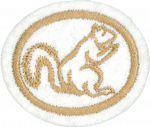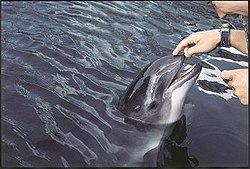Especialidades JA/Mamíferos/Respuestas
| Mamíferos | ||
|---|---|---|
| Asociación General
|
Destreza: 1 Año de introducción: 1937 |
|
Requisitos
|
La especialidad de Mamíferos es un componente de la Maestría Zoología. |
| Conexión Logros para la Investidura: Esta especialidad está relacionada con los requisitos de Logros para la Investidura para AMIGO Estudio de la naturaleza que requiere informar sobre los mamíferos visitantes observados, similar al requisito 8 de esta especialidad. Esta especialidad es una elección popular para la especialidad de la categoría de Estudio de la naturaleza de nivel de destreza 1 requerido para los AMIGOS DE LA NATURALEZA. |
1
Génesis 1:24, 25, 31
| Génesis 1:24-31 |
|---|
24 Luego dijo Dios: «Produzca la tierra seres vivientes según su especie: bestias, serpientes y animales de la tierra según su especie.» Y fue así. 25 E hizo Dios los animales de la tierra según su especie, ganado según su especie y todo animal que se arrastra sobre la tierra según su especie. Y vio Dios que era bueno. 26 Entonces dijo Dios: «Hagamos al hombre a nuestra imagen, conforme a nuestra semejanza; y tenga potestad sobre los peces del mar, las aves de los cielos y las bestias, sobre toda la tierra y sobre todo animal que se arrastra sobre la tierra.» 27 Y creó Dios al hombre a su imagen, a imagen de Dios lo creó; varón y hembra los creó. 28 Los bendijo Dios y les dijo: «Fructificad y multiplicaos; llenad la tierra y sometedla; ejerced potestad sobre los peces del mar, las aves de los cielos y todas las bestias que se mueven sobre la tierra.» 29 Después dijo Dios: «Mirad, os he dado toda planta que da semilla, que está sobre toda la tierra, así como todo árbol en que hay fruto y da semilla. De todo esto podréis comer. 30 »Pero a toda bestia de la tierra, a todas las aves de los cielos y a todo lo que tiene vida y se arrastra sobre la tierra, les doy toda planta verde para comer.» Y fue así. 31 Y vio Dios todo cuanto había hecho, y era bueno en gran manera. Y fue la tarde y la mañana del sexto día. |
2
- 1. Endotérmico (sangre caliente)
- 2. Pelo
- 3. Glándulas mamarias (productoras de leche)
- 4. Glándulas sebáceas (secretoras de grasa)
- 5. Dentadura heterodoncia (diferentes formas de dientes en la boca)
3
3a
3b
3c
3d
3e
3f
3g
3h
|
3i Sirenios
3j Cetáceos
4 Hacer una lista de cuatro mamíferos beneficiosos y decir cómo son beneficiosos.
5 Hacer una lista de cuatro cosas que hacen los mamíferos que son perjudiciales.
Accept all reasonable answers.
6 Hacer una lista de cinco mamíferos que son completamente acuáticos y designar su área de distribución natural.
7 Mencionar al mamífero más grande en el mundo y decir dónde vive, cómo se alimenta, y lo que come.
The Balaenoptera musculus (Blue Whale) is the largest animal on the planet. Specimens have been recorded over 30 meters in length and are estimated to weigh more than 90 tonnes. These whales have been seen in every ocean of the world and feed by filtering the water through the giant balleen plates in their mouth. Adult whales can eat up to 4 tonnes krill (euphausiids) and copepods each day and the calves can drink up to 400 litres/day. These amazing creatures were hunted by man to the brink of extinction. Over 378,000 were killed to provide oil and whale meat. The population of B. musculus (Blue Whales) is now only about 1% of the total 100 years ago.
8 Hacer una lista de ocho especies de mamíferos silvestres que se encuentran en su región. Usar por lo menos cinco horas en la búsqueda de los mamíferos silvestres en su hábitat natural.
9 Escribir o contar una historia sobre «Los mamíferos silvestres que he observado».
A good opportunity for a story would obviously be the 5 hour search in the last requirement, if you can't think of another story about wild mammals that you have observed.
References
|
- Categoría: Tiene imagen de insignia
- Adventist Youth Honors Answer Book/Honors/es
- Adventist Youth Honors Answer Book/es
- Adventist Youth Honors Answer Book/Skill Level 1/es
- Categoría: Libro de respuestas de especialidades JA/Especialidades introducidas en 1937
- Adventist Youth Honors Answer Book/General Conference/es
- Adventist Youth Honors Answer Book/Nature/es
- Adventist Youth Honors Answer Book/Nature/Primary/es
- Adventist Youth Honors Answer Book/Stage 0/es
- Categoría:Libro de Respuestas de Especialidades JA/Maestría Zoología/requerido
- Adventist Youth Honors Answer Book/IAConnection/es
- Pages with broken file links
- AY Honors/Do at home/es
- AY Honors/Covid Tips/es
- Adventist Youth Honors Answer Book

































